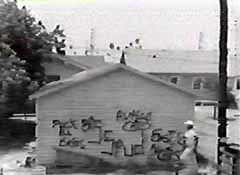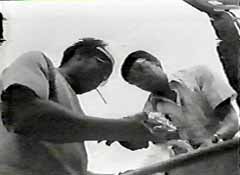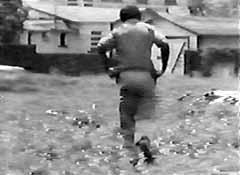|

Charlie paints over graffiti on a
garage in Bless Their Little Hearts.
Bless Their Little Hearts has much is common with neo-realism as well. Near the end of the film, Charlie and his friends concoct a scheme to catch fish and sell them on the highway to passing motorists. This scheme ends in futility as the fish do not sell and Charlie walks off into an empty field to face his continued futile existence. Again, the fish selling scheme is directly reminiscent of La Terra Trema's boat scheme that only leads to the family's return to working for other people. The film also has many non-professional actors, most notably the three Banks children who were actually Burnett's three children. The film has many long takes (a film technique long associated with realism), one being the fight between Charlie and his wife. This scene is mostly improvised and carries on, uncut, for over five minutes. For an improvised scene, the dialogue does not suffer from any hint of inexperience. Ed Guerrero writes of this scene, "The action between Charlie and Andais is improvised, allowing the actor and actress to draw upon their own cultural repository of gestures, experiences, and memories to animate the scene" (320). It is this cultural repository of the non-professional actor, in a sense a real person, that makes the realist text real. It isn't acting with the non-professional actor that makes it real, it is their cultural identity allowed to permeate the scene. Like both Killer of Sheep and Nothing But a Man, Bless Their Little Hearts cites the bombed out milieu of Paisan's Italy as well. As Charlie returns from one of his menial jobs, ruined and abandoned factories pass by in the background. By 1984, South-Central hasn't changed, perhaps only gotten worse.

Charlie's friends try selling fish from the
trunk of a car in Bless Their Little Hearts.
Unlike Killer of Sheep and Nothing But a Man, Bless Their Little Hearts ends with futility. As Charlie walks off into the field, we are left with nothing but a continued feeling of hopelessness. Why does the film differ in this way from other black independent films? What has happened to the "struggle" and the unwillingness to give into futility? Bless Their Little Hearts comes at an important historical juncture in black existence. Ed Guerrero writes, "Bless Their Little Hearts is set in an historical moment occurring only an instant before the genocidal explosion of drugs and gang violence in black communities across the nation" (321-2). No doubt the underlying causes of drugs and gangs were already becoming evident even before the film was made. It is this historical moment that has finally pushed hope completely out of the picture. Drugs and gangs are in part a direct result of oppression and poverty that pervade the inner city and they are two issues not dominant in 1964 and 1977. While drugs and gangs are not issues that occur in Bless Their Little Hearts, it is the underlying causes of drugs and gangs, already firmly entrenched in the black community by 1984, that have pushed futility to dominate. Drugs and violence have been folded into the black community where the only outlet available is on other blacks (a fact that gang violence vividly demonstrates). The "struggle" has met the most insidious of obstacles, and futility has become dominant. Considering Burnett's optimism as displayed in the end of Killer of Sheep, he and Woodberry have changed their social outlook and saw obstacles that mere hope could not overcome. This in fact is a telling marker considering the return to violence and riots that would soon envelop Los Angeles. That is in part why Bless Their Little Hearts departs from previous black independent film. Its historical moment is quite different from 1977 and 1964. A hope grounded in the simplicity of perseverance is no longer a vital socio-personal strategy. A return to the rhetoric of the Black Power movement was. America would soon be awakened to this through more rioting and the return of violent black images on the screen through such films as New Jack City and Boys N the Hood.

Charlie gives up the fish-selling scheme
and walks away in Bless Their Little Hearts.
From 1964 to 1984, these three films chart the struggles of black Americans from the inside, a place no Hollywood film dare go. As white America smugly believes they have done all they can do for black Americans, the progression of the "struggle" as seen in these three films shows that white hegemony is as pervasive as always. Neo-realism quickly became removed from its social ties in Italy as post-war conditions returned to normal. Black independent neo-realism has lost none of its social ties and that is why these films are still making "history." They have not become a simple chronicle of the past. They are still making connections with the present and that is why these films need to be shown and viewed. While these three films vary in the depiction of hope, futility and struggle, they all share one underlying theme which has incredible social urgency. That theme is "we cannot let futility win." It is this social urgency that must be continually addressed if futility is to be permanently displaced by hope.
page 4 of 4
 
Page One Introduction
Page Two Killer of Sheep
Page Three Nothing But a Man
Page Four Bless Their Little Hearts
Go to Works cited.
Chris Norton received his B.A. in English and Film Studies from Oakland University, Rochester, Michigan and an M.A. from New York University in the Department of Cinema Studies. Chris welcomes comments or questions about his article. You can reach him at norteiga@aol.com.
|




